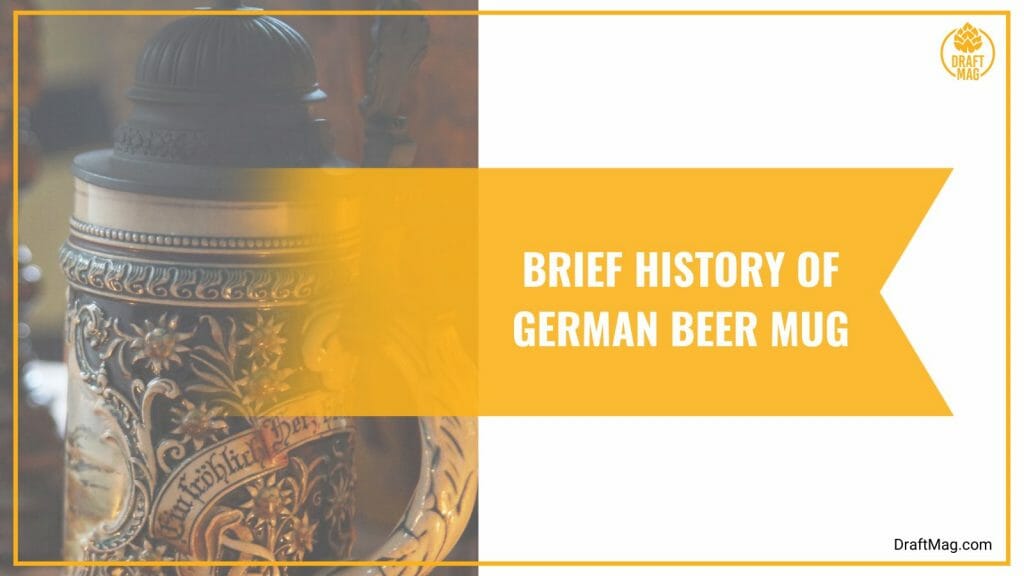German Beer Mug Name: The Names and Types of This Vessel
The German beer mug name is traditionally called a stein, but it has other names which may refer to the volume of beer that it can hold. Some of these mugs go as far back as the 14th Century at the height of the bubonic plague that ravished much of Europe, North Africa and Asia.

Today, it has become a souvenir or collectible that can be traded for other valuable items. This article will discuss a brief history of the mugs, their various names, types and the volumes of beer they can contain.
What Is the Name of the German Beer Mug?
The name of the German beer mug is generally referred to as a stein, which is the German word for stone. This is because the mugs used to be made of stoneware such as earthenware, ceramics, porcelain and creamware when it was first invented.
However, steins can also be made of different materials such as pewter, silver, crystals, glass or even wood.
– Pints in a Stein
How many pints a stein can hold depends on the beer stein size. For example, a typical ceramic beer stein mug should be able to hold 2 pints of beer.

An Oktoberfest beer stein with a lid can also hold up to 2 pints. However, some Mettlach steins or stoneware German beer mugs can hold over 3 pints of alcohol.
– Other German Beer Mug Names
Various regions in Germany refer to beer mugs with different names, though all of the names convey similar meanings. Here are a few ways of referring to German mugs:
- Maßkrug: This word “Maß” is the German word for “Mass” and is usually used to refer to any type of German mug that can hold 1 liter of beer. It is very popular at German beer gardens and beer halls. Note that the maßkrug can only translate into beer stein if it is made of stoneware and can hold 1 liter of beer. This means that maßkrug originally refers to tall glasses of beer and not beer steins.
- Bierkrug: This word comes from the combination of two words “Bier” which means beer, and “Krug” which means jar. However, the two words together typically mean beer stein, which can hold any volume of beer from 0.5 liters to 2 liters.
- Humpen: This word means “tankard,” which is another name for a beer stein and can contain beer between 0.5 liters and 2 liters. This is typically made from German stoneware.
- Adlerhumpen/Alder-Humpen/Wilkomm-Humpen: These words indicate very tall glasses with handles used for consuming beer. These glasses became prominent in the 16th Century when producers started using enamel paint to design them. The most common glass was designed in the shape of the double eagle of the Roman Empire with the names of the 56 electors of the empire imprinted on the outspread wings of the eagle. These glasses could typically hold 0.5 liters of beer.
- Schoppen: In the Palatinate region of Germany, the word stein is used to describe a mug that can hold 1 liter of beer, thus anyone preferring a smaller mug used the word “schoppen,” which meant half a liter. As the name suggests, schoppens can only hold 0.5 liters of beer.
- Keferloher: This is an antique mug that was plain with no designs nor beer stein markings. It mostly looked dull and unattractive but could hold 1 liter of beer. It was named after the village Keferloh in which it was originally manufactured and perfect for serving vintage German beer.
- Seidel/Seidla: This refers to a beer mug that can hold between 0.3 liters to 0.5 liters of beer. The meaning of the word is “vessel” and is mainly used in the Franconia region of Germany.
– Difference Between German Mug and Stein
Interestingly, other sources maintain that there is a difference between German mugs and Steins. According to them the mugs, known in German as bierkrug, holds less beer than steins and are less robust with none to only a few designs.

German Mugs can hold between 0.5 Liters to 1 Liter of beer. On the other hand, Steins also referred to as Oktoberfest steins are stronger, larger, have more intricate designs and can hold drinks between 0.25 and 2 Liters.
However, given that many sources believe German beer mugs are the same as beer steins, we will go with that. Thus, these words will be used interchangeably in the next paragraphs.
– Brief History of German Beer Mug
The popular story behind the production of lidded beer steins is that they were made during the Black Death with lids attached to prevent fleas from falling into the beers. According to them, the plague was spread by the fleas, thus covering the beers helped in curtailing the disease.
However, some sources doubt the veracity of this story because according to them, the belief in those days was that the plague spread through miasmas which were unpleasant aromas or vapors. Whatever the reason for making beer steins, one thing is for sure: beer steins became popular at the beginning of the Renaissance era.
At the time, steins were made of stoneware, hence their name which means stone. Scholars say that the first materials used in making these mugs were earthenware and wood. However, these materials were porous and couldn’t store beer for long. Also, they were difficult to clean and became putrid with prolonged use.

Soon, pewter was introduced to help with the problems posed by wood and earthenware, but there was a problem. It was expensive and came with pewter lids that only the rich could afford, thus the lower-class citizens of German society had to make do with clay and wood. As the years went by, other materials were used to make beer steins including ceramics, porcelain, glass and crystals. Today, German beer steins are mostly made of porcelain or ceramics and are still used to consume beer, especially during Oktoberfest.
These mugs that are used during Oktoberfest are called maßkrug and can hold up to 1 liter of beer. Humpen is another popular mug at Oktoberfest due to its size and strength, and this type of mug translates to “tankard” in English.
What Are the Kinds of German Beer Steins?
The different kinds of German beer steins include wooden/carved steins, regimental steins, ivory steins, Mettlach steins, glass-blown beer steins, and character steins. These are the various kinds of beer steins and each has its own unique characteristics that set it apart from others.
Interestingly, these steins are unique to certain periods and cultures. Here are some of the most prominent types:
– Wooden/Carved Steins
These German mugs are carved from wood with complex hand painted designs that are reminiscent of the old Germanic people of Scandinavia. The large German beer steins usually feature detailed reliefs of battle scenes alongside sophisticated patterns that are enchanting.

It took days and sometimes months to finish a carved stein, so they are quite expensive due to the painstaking process. However, others are made by machines that come at a cheaper price.
– Regimental Steins
Regimental steins were used to commemorate events on the battlefield and were usually handed over to soldiers as a “thank you” gift in the German military. These steins were designed with the name of the soldier, their rank, and their accomplishments. The Germans started producing the regimental steins between 1890 and 1914 when young men around 18 to 21 years had to undergo military training. It was common, at the time, to purchase some memorabilia that would remind them of their time in training and members of their units.
Many soldiers preferred German beer steins because they had all the names of the soldiers in their unit written on them, hence the name “Regimental Steins.” These mugs are hand-crafted mostly from stone or earthenware and become a family property that is handed from one generation to the next. However, modern-day regimental steins are made from porcelain and by machines which are able to mimic vintage designs so well that it is difficult to differentiate them.
– Ivory Steins
These steins were designed from ivory and are among the rarest beer mugs due to several laws banning the use of ivory. The material is derived from the tusks of elephants which are mostly hunted and killed for them.
A few surviving ivory steins feature intricate designs that are comparable to Greek and Roman sculptures. However, it is advisable to check the legal status of an ivory stein before using it, so you don’t fall foul of the law.
– Mettlach Steins
They are called Mettlach steins because they come from the municipality of Mettlach in the state of Saarland. The company famous for producing these German mugs is the Villeroy & Boch factory, which has been in business since the 19th Century.
For years it was at the forefront of producing distinctive beer mugs with inlay lids which became the standard for beer stein producers across Europe. Mettlach steins come in different sizes, designs, shapes and colors.

Many collectors like to keep a Mettlach Stein because they are well-marked and easily identifiable as well as have original designs and are marketable. They also play their original role, which is to keep beer fresh and tasty while the patrons take their time to enjoy each sip of a tasty ale.
The types of Mettlach steins include Hourglass, Tavern, Bavarian, Hofbrau, Chalice, Traditional, Potbelly, Smokestack, Barrel and Lodge. Mettlach Steins can store between 0.3 Liters to 7 Liters of beer and the largest Mettlach stands at a whopping 12 inches.
– Glass-Blown Beer Stein
As the name suggests, glass-blown beer steins are etched beer glasses and are amongst the earliest beer steins to be produced. These beer glasses also come in different shapes and sizes and are decorated with intricate designs and they come in various colors including green and cobalt blue. These beer glasses are designed to hold about half a liter to 1 liter of beer and can easily be cleaned.
The famous beer boot is an example of a glass-blown stein. The beer boot tradition started in the military where recruits were made to drink about a liter of beer from real boots. Today, many people fancy drinking beers from beer boots just for fun or to keep the glass beer stein as a memento.
– Character Steins
Character steins are mostly made from ceramics and porcelain and can be shaped into any character that the designer wants. These characters typically represent ideas, symbols, memories, or emotions and stein designers often use animals as their stein characters to convey these messages. For example, a fox stein will probably represent cunningness or trickery while a dog may represent loyalty. Character steins are among the most artistic German beer steins due to their vast array of shapes.
These German steins come in different sizes ranging from 8.5 inches to 12 inches and their volume is between 0.75 liters to 1.2 liters. They are perfect gifts for stein collectors or beer connoisseurs who love to drink from German mugs. Most collectors also prefer to use them as personalized beer steins.
Conclusion
We’ve looked at the various names and types of German beer mugs and the amount of alcohol each can hold. Here is a summary of all that we’ve read:
- Though German mugs are typically called steins, they also have other names such as humpen, bierkrug and schoppen.
- These steins can typically hold between 0.5 liters to 2 liters of beer, though the volume could be more.
- The most popular beer steins are the character steins, which come with stein lids and are great gifts for family and friends.
German beer steins are made of various materials including pewter, earthenware, and glass, and some even come with lids to keep flies and other contaminants out.






